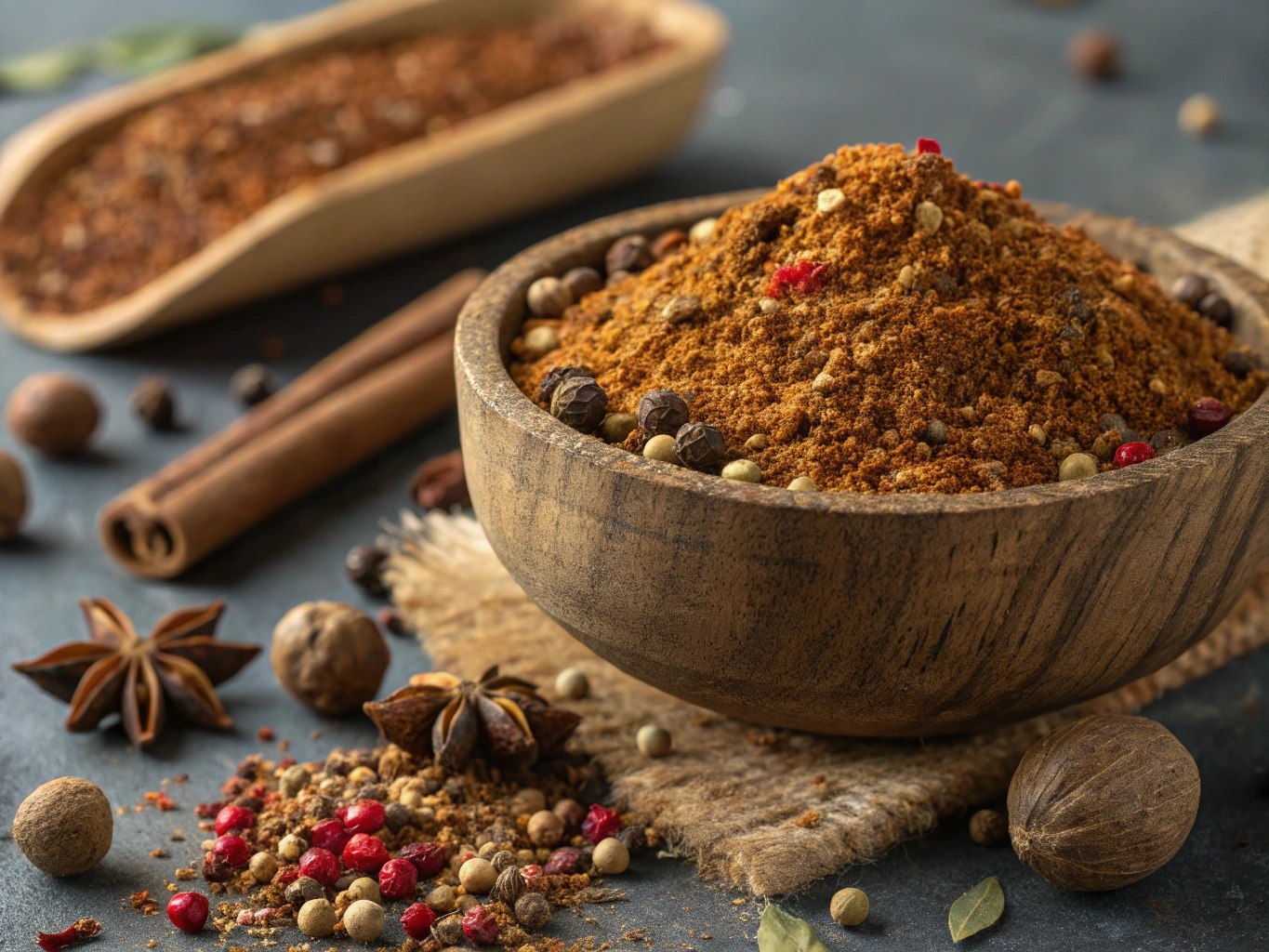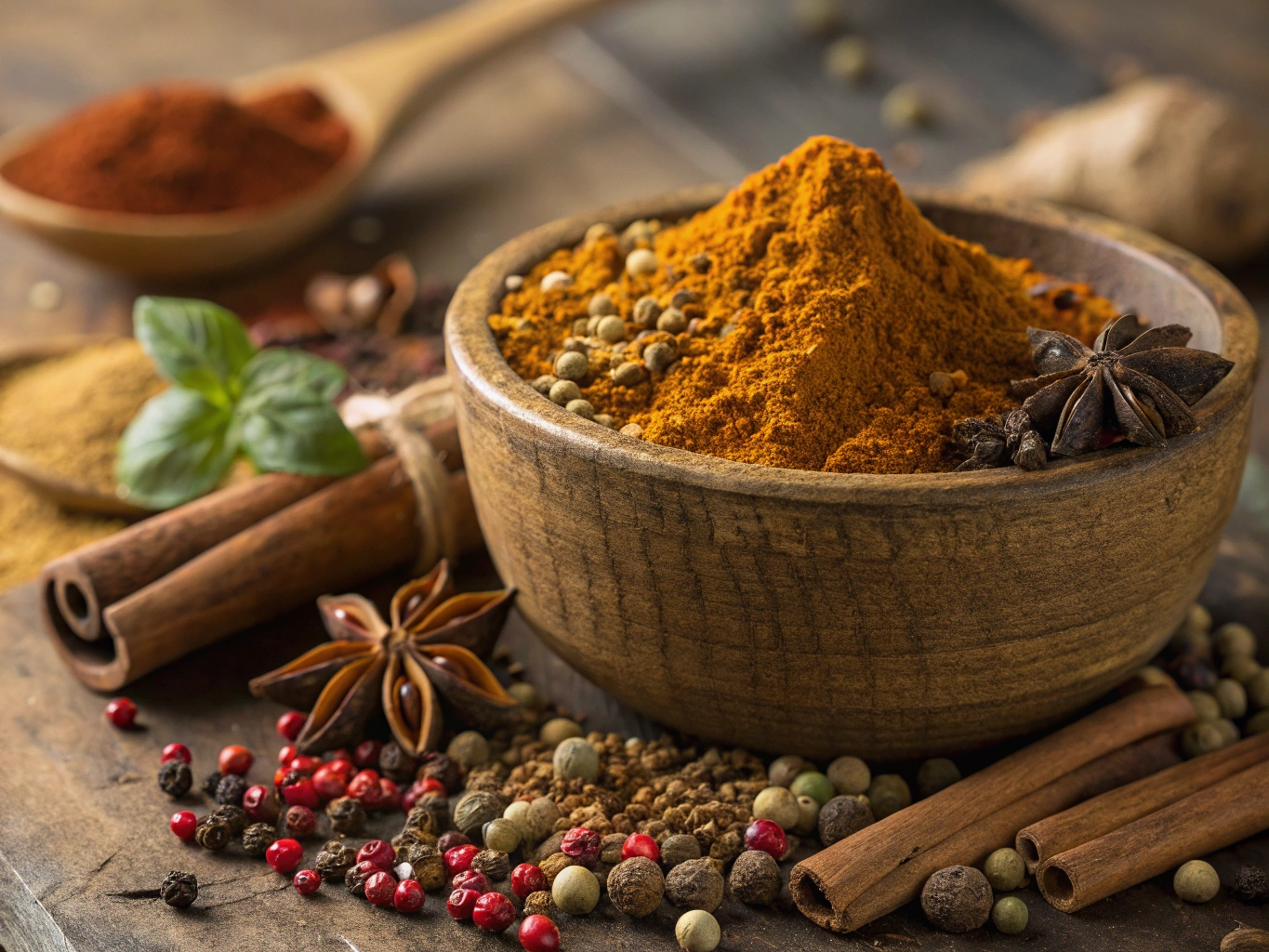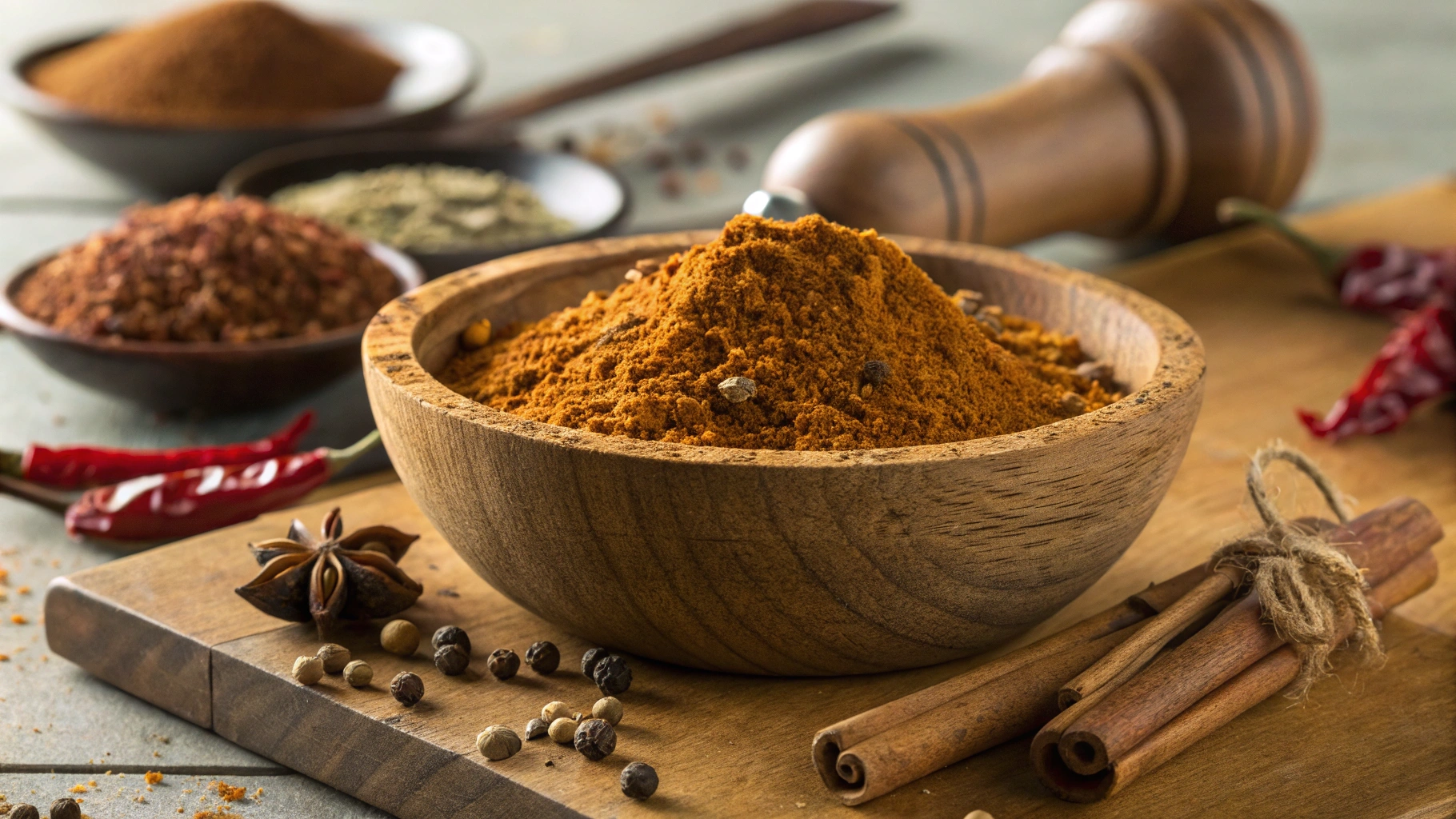Have you ever caught the beguiling aroma of a Lebanese kitchen wafting through the air? That distinctive, alluring fragrance likely owes its magic to a special blend known as Lebanese 7 Spice. More than just a seasoning, this aromatic mixture carries generations of culinary heritage in every granule.
As a child visiting my grandmother’s home in Beirut, I remember watching her weathered hands deftly combining spices from small clay pots, measuring by eye and testing with her nose. “This is our secret,” she would whisper, “the soul of our cooking.” Though she never wrote down her recipe, the memory of that scent—warm, complex, and infinitely comforting—stayed with me forever.
- Bist Amazon Picks:
Today, I’m sharing the secrets of crafting authentic Lebanese 7 Spice in your own kitchen. This isn’t just about following a recipe; it’s about connecting with centuries of tradition, honoring the meticulous balance of flavors that Lebanese cooks have perfected over generations, and bringing that magic into your everyday cooking.
What Is Lebanese 7 Spice and Why It’s Essential in Middle Eastern Cuisine
Lebanese 7 Spice, often called “baharat” (Arabic for “spices”), stands as the cornerstone of Lebanese cuisine. Unlike its counterparts in other Middle Eastern regions, the Lebanese variation maintains a distinctive flavor profile that balances warmth and subtlety without overwhelming heat.
Dating back centuries, this spice blend evolved through trade routes that connected Lebanon to spice-rich regions across Asia and Africa. What makes this blend exceptional is its perfect harmony—no single spice dominates, yet each contributes an essential note to the symphony of flavors.
In traditional Lebanese homes, this blend isn’t merely a seasoning but a cultural touchstone. It represents hospitality, family gatherings, and celebrations. The blend varies slightly from village to village, family to family—each guarding their particular ratio as a culinary inheritance.
While similar to other regional blends, Lebanese 7 Spice distinguishes itself through its balanced approach. Unlike Moroccan mixes that lean heavily on peppery heat or Turkish varieties that emphasize floral notes, the Lebanese blend creates a rounded profile where warm spices complement rather than compete with each other.
The Essential Ingredients of Authentic Lebanese 7 Spice
Understanding Each Component

The magic of Lebanese 7 Spice emerges from the interplay of seven distinct elements, each bringing its unique character to the mixture:
| Spice | Flavor Profile | Traditional Role |
|---|---|---|
| Black Pepper | Sharp, pungent | Provides heat and depth |
| Allspice | Sweet, warm | Forms the foundation |
| Cinnamon | Sweet, woody | Adds warmth and sweetness |
| Cloves | Strong, aromatic | Brings intense fragrance |
| Nutmeg | Warm, nutty | Contributes complexity |
| Coriander | Citrusy, floral | Adds brightness |
| Cumin | Earthy, warm | Grounds the blend |
Each component plays a crucial role—the black pepper provides necessary heat without overwhelming, while allspice forms the backbone of the mixture. Cinnamon and cloves bring that distinctive warmth that makes Lebanese dishes so comforting. Nutmeg adds mysterious depth, while coriander contributes essential brightness. Finally, cumin grounds everything with earthy undertones that complete the blend’s character.
Regional Variations and Optional Additions
While the classic seven spices form the traditional core, regional adaptations throughout Lebanon introduce fascinating variations:
Northern Lebanese blends occasionally incorporate small amounts of ginger for added warmth, while coastal regions might introduce a hint of dried lime for citrus notes. Mountain villages sometimes add cardamom for heightened aromatic qualities, particularly in versions designed for coffee or desserts.
Family recipes show even greater diversity—some include mahlab (ground cherry pits) for almond-like notes, while others might add tiny amounts of star anise for licorice undertones. These variations reflect Lebanon’s rich culinary diversity across its numerous microclimates and cultural influences.
How to Make the Perfect Lebanese 7 Spice Blend at Home
Sourcing Quality Spices

The foundation of an extraordinary Lebanese 7 Spice blend begins with exceptional ingredients. Seek out these guidelines when sourcing your spices:
Look for spices with vibrant colors and strong aromas—dull, dusty spices have likely lost their essential oils. Whenever possible, purchase whole spices rather than pre-ground varieties; they maintain flavor compounds significantly longer and allow you to toast them for enhanced aroma.
Specialty Middle Eastern markets typically offer the freshest options, often with higher turnover than conventional grocery stores. Online spice merchants specializing in Middle Eastern cuisine provide another excellent source, particularly for harder-to-find whole spices like high-quality allspice berries.
When examining spices, black peppercorns should feel hard and dense, cinnamon sticks should be tightly rolled with minimal cracking, and cloves should have intact heads with minimal stem damage. For nutmeg, select specimens that feel heavy for their size, indicating higher oil content.
Essential Equipment
Crafting authentic Lebanese 7 Spice doesn’t require extensive equipment, but certain tools will elevate your results:
- A dedicated spice grinder or coffee grinder enables you to freshly grind whole spices just before blending
- A small, heavy skillet (preferably cast iron) works perfectly for toasting spices
- A mortar and pestle offers traditional grinding methods that release oils differently than electric grinders
- Airtight glass containers with dark tinting protect the finished blend from light damage
- Small metal measuring spoons ensure consistent ratios
While purists might insist on manual grinding with a mortar and pestle, electric grinders produce wonderfully consistent results with significantly less effort. The key lies in grinding spices just before blending rather than storing pre-ground mixtures.
Step-by-Step Recipe
Traditional Lebanese 7 Spice Recipe
| Ingredient | Quantity | Notes |
|---|---|---|
| Black peppercorns | 2 tablespoons | Freshly ground for best flavor |
| Allspice berries | 2 tablespoons | Whole berries, not ground |
| Cinnamon sticks | 1 stick (or 1 tablespoon ground) | Ceylon cinnamon preferred |
| Whole cloves | 1 tablespoon | Toast lightly for enhanced aroma |
| Whole nutmeg | 1/2 nutmeg (or 1 teaspoon ground) | Freshly grated if possible |
| Coriander seeds | 1 tablespoon | Adds citrusy notes |
| Cumin seeds | 1 teaspoon | Use sparingly to not overpower |
Follow these steps for the perfect blend:
- Begin by lightly toasting your whole spices. Heat a dry skillet over medium-low heat and add the coriander, cumin, black peppercorns, and allspice berries. Move them constantly for 2-3 minutes until they become fragrant but not darkened. Remove immediately to prevent burning.
- Allow the toasted spices to cool completely before grinding—this prevents moisture from condensing in your grinder and causing clumping.
- Working in small batches, grind each spice separately to ensure consistent texture. The peppercorns particularly benefit from separate grinding as they require more force than other spices.
- If using whole nutmeg, grate it using a microplane or the finest setting on your grinder.
- Combine all ground spices in a mixing bowl, then sift through a fine mesh strainer to remove any larger pieces for a uniformly textured blend.
- Test the balance by warming a small amount in your palm and smelling the release of aromas. You should detect layers of fragrance rather than any single dominating note.
- Mix thoroughly using a whisk or fork, ensuring even distribution of all seven elements.
Modern Variations for Different Tastes
For a milder version that appeals to sensitive palates, reduce the black pepper by half and cloves to 1/2 tablespoon. This creates a gentler blend that works beautifully with delicate fish dishes or vegetables.
Craving more heat? Create a spicier adaptation by maintaining the traditional ratios but adding 1/2 teaspoon of cayenne pepper or Aleppo pepper flakes. This variation pairs exceptionally well with grilled meats or hearty stews.
For an aromatic version that excels in desserts and coffees, increase cinnamon to 1 1/2 tablespoons and add 1/2 teaspoon of ground cardamom. This sweeter profile complements rice puddings and fruit-based dishes beautifully.
Storing Your Homemade Lebanese 7 Spice Blend
The effort you’ve invested in creating your perfect Lebanese 7 Spice deserves proper storage techniques that preserve its nuanced flavors:
Dark amber or opaque glass containers offer the best protection against light degradation, which can quickly diminish aromatic compounds. Always select containers with airtight seals—oxygen exposure ranks among the quickest ways to flatten spice flavors.
Store your precious blend away from heat sources like stoves or sunny windowsills. The ideal storage location combines darkness, cool temperatures, and low humidity—typically a pantry or cabinet away from your cooking area.
When properly stored, your homemade Lebanese 7 Spice maintains peak flavor for approximately 3-4 months. After this period, while not harmful, the blend gradually loses its aromatic complexity and may require larger quantities to achieve the same flavor impact.
Watch for these signs that indicate it’s time for a fresh batch: noticeably diminished aroma when warmed in your palm, faded coloration (particularly the vibrant reddish-brown hues), or the need to use increasingly larger amounts in recipes.
How to Use Lebanese 7 Spice in Traditional and Modern Cooking
Classic Lebanese Dishes Enhanced by 7 Spice
Lebanese 7 Spice transforms ordinary ingredients into extraordinary dishes across numerous traditional preparations:
For authentic kibbeh (Lebanon’s national dish of spiced meat and bulgur), incorporate 1 1/2 teaspoons of Lebanese 7 Spice per pound of meat. The blend brings depth that complements the richness of the meat without overwhelming it.
When preparing kafta (seasoned ground meat skewers), add 2 teaspoons per pound of meat, allowing the blend to fully permeate the mixture before grilling. The heat releases additional aromatic compounds for a multi-layered taste experience.
Lebanese stews, particularly those featuring lamb or beef, benefit from 1 tablespoon added early in the cooking process. This allows the spices to infuse throughout the liquid, creating a profoundly flavored base.
Creative Modern Applications
Beyond traditional uses, Lebanese 7 Spice offers remarkable versatility in contemporary cooking:
Transform ordinary roasted vegetables by tossing them with olive oil and 1 teaspoon of Lebanese 7 Spice before roasting. The blend particularly enhances sweet potatoes, cauliflower, and winter squash.
Create distinctive soups by adding 1/2 teaspoon to pureed vegetable bases like butternut squash or carrot. The warming spices complement the natural sweetness while adding complexity.
For unexpected but delightful marinades, combine 2 teaspoons with olive oil, lemon juice, and garlic before applying to chicken, fish, or even tofu. Allow at least 30 minutes of marination for the flavors to penetrate.
Fusion cuisine opens endless possibilities—try adding a pinch to Italian risotto, incorporating into Mexican beans, or even sprinkling lightly over popcorn with a drizzle of butter for an elevated snack experience.
Perhaps most surprisingly, certain desserts welcome the complexity of Lebanese 7 Spice. Try adding 1/4 teaspoon to chocolate cake batter or incorporating into cookie dough alongside traditional warm spices for dimensions of flavor that will intrigue and delight.
Pairing Lebanese 7 Spice with Other Flavors
Lebanese 7 Spice forms brilliant partnerships with complementary ingredients:
Fresh herbs like mint, parsley, and cilantro provide bright counterpoints to the warm spice notes. These pairings work particularly well in grain-based dishes or fresh salads dressed with lemon and olive oil.
For protein pairings, lamb stands as the traditional favorite, with the blend cutting through rich fattiness while enhancing the meat’s natural flavor. Chicken readily absorbs the spice notes during cooking, while beef develops remarkable depth when seasoned generously.
Plant-based options aren’t left behind—lentils, chickpeas, and eggplant absorb the spices beautifully, creating satisfying meat-free dishes with authentic Lebanese character.
Troubleshooting Your Lebanese 7 Spice Blend
Even experienced cooks encounter challenges when crafting this complex blend. Here’s how to address common issues:
If your blend tastes overwhelmingly of one spice (particularly cloves or cumin, which can easily dominate), dilute the mixture by adding small amounts of the other components until balance returns. Start with allspice and cinnamon to restore harmony without introducing additional strong flavors.
When your blend lacks sufficient aromatic impact, the likely culprit isn’t quantity but freshness. Rather than adding more, consider replacing your oldest spices with freshly purchased and newly ground versions.
For blends that taste flat or dull despite using quality ingredients, the missing element might be proper toasting. Try making a small batch with carefully toasted whole spices, paying special attention to the subtle color changes that indicate released essential oils.
Conclusion
Creating Lebanese 7 Spice at home transcends mere cooking—it connects you with centuries of culinary wisdom. Through this careful balancing of seven elements, you participate in a tradition that has brought comfort and celebration to countless tables across generations.
As you incorporate this versatile blend into everything from traditional Lebanese classics to innovative modern creations, you’ll discover how a relatively simple combination of spices can transform ordinary meals into memorable experiences. The beauty of crafting your own blend lies in the opportunity for personal expression—adjusting ratios slightly to suit your palate while respecting the essential balance that defines this venerable mixture.
So gather your spices, prepare your grinder, and embark on this aromatic journey. Your kitchen will thank you, your meals will transform, and you’ll carry forward a tradition that has delighted discerning palates for centuries. The perfect Lebanese 7 Spice blend awaits your creation—and with it, countless delicious possibilities.
Frequently Asked Questions About Lebanese 7 Spice
What makes Lebanese 7 Spice different from other spice blends?
Lebanese 7 Spice distinguishes itself through its balanced approach to warm spices. Unlike other regional blends that might emphasize heat (like Moroccan) or floral notes (like Turkish variations), Lebanese 7 Spice creates a harmonious profile where no single element dominates. The presence of allspice as a foundation also sets it apart from many other Middle Eastern blends.
Can I substitute pre-ground spices when making Lebanese 7 Spice at home?
While whole spices freshly ground provide optimal flavor, pre-ground spices can work in a pinch. If using pre-ground options, reduce their shelf time by purchasing in smaller quantities from stores with high turnover. You’ll miss the aromatic benefits of toasting whole spices, but can still create a functional blend. Consider increasing quantities slightly (about 10-15%) to compensate for the diminished potency.
How long will homemade Lebanese 7 Spice last before losing its flavor?
When stored properly in airtight, light-resistant containers away from heat, your Lebanese 7 Spice blend maintains peak flavor for 3-4 months. While safe to consume beyond this period, you’ll notice gradually diminishing aromatic qualities. Creating smaller batches more frequently ensures you always experience the blend’s full flavor potential.
What’s the best first recipe to try with my homemade Lebanese 7 Spice?
For newcomers to Lebanese 7 Spice, start with a simple roast chicken. Combine 2 teaspoons of your blend with olive oil, crushed garlic, and lemon juice, then rub thoroughly over a whole chicken before roasting. This straightforward application showcases the blend’s transformative power without requiring complex techniques or additional specialty ingredients.
Is Lebanese 7 Spice the same as baharat?
Lebanese 7 Spice represents a specific regional variation of baharat (which simply means “spices” in Arabic). While all baharat blends contain similar warm spices, the Lebanese version typically features more prominent allspice and less paprika than other regional variations. The term “baharat” encompasses many Middle Eastern spice blends, with Lebanese 7 Spice being one distinctive expression.
Can I adjust the Lebanese 7 Spice recipe if I don’t like certain spices?
While traditional Lebanese 7 Spice derives its character from the balance of all seven components, minor adjustments can accommodate personal preferences while maintaining authenticity. Consider reducing rather than eliminating challenging spices—for instance, halving the cloves or cumin if you find them overpowering. This preserves the essential character while creating a more personally appealing blend.
What dishes are traditionally seasoned with Lebanese 7 Spice?
Lebanese 7 Spice traditionally enhances a wide variety of dishes including kibbeh (spiced meat and bulgur wheat), kafta (seasoned ground meat skewers), various meat stews, stuffed vegetables (particularly eggplant and zucchini), and mujadara (lentils and rice). The blend also appears in many stuffing mixtures for grape leaves, cabbage rolls, and stuffed squash varieties.

